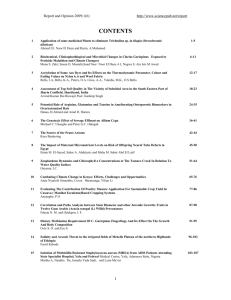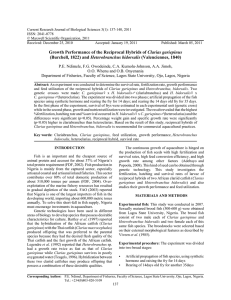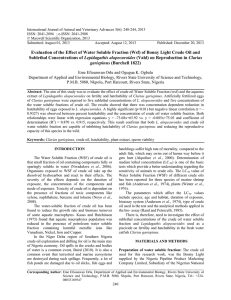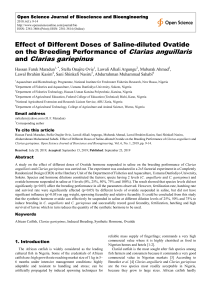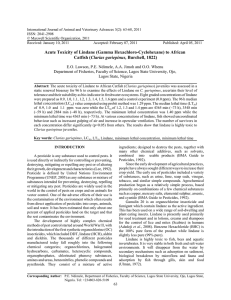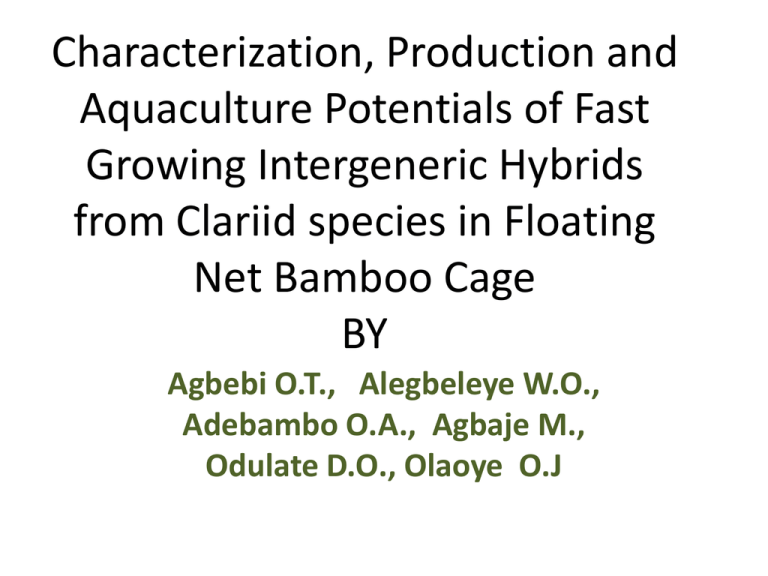
Characterization, Production and
Aquaculture Potentials of Fast
Growing Intergeneric Hybrids
from Clariid species in Floating
Net Bamboo Cage
BY
Agbebi O.T., Alegbeleye W.O.,
Adebambo O.A., Agbaje M.,
Odulate D.O., Olaoye O.J
INTRODUCTION
• Aquaculture production in Africa is still
insignificant at the global level and accounts for
about 0.9 percent the total global aquaculture
production in 2000 (FAO, 2003)
• Heterobranchus and Clarias species are leading
freshwater candidates for aquaculture in Africa,
similar in appearance but have differential
growth performances in culture. There are many
heteroclarias and Clariobranchus types being
produced by aquacultural practitioners in Nigeria
without paying attention to the type of hybrid
fingerlings being released to the ponds or culture
medium.
INTRODUCTION CONTD
• These F1 hybrids have been reported to be fertile
(Aluko, 1998; Nwadukwe, 1995).
• The problem posed by this is the indiscriminate
use of these fertile hybrids as broodstock for
further propagation posing a serious threat to the
purity of our indigenous Clariid species.
Furthermore, there is need to harmonise the
growth records of these hybrids and recommend
the fastest growing hybrids. This study was
therefore designed to determine the fastest
growing F1 hybrids for culture using two Clariid
species: H. bidorsalis, and C. gariepinus
domesticated and wild strains
Objectives of the study
• Morphological, meristic and molecular characteristics
of Clarias gariepinus and Heterobranchus bidorsalis of
the parent stocks.
• Characterisation of the strains using microsatellite
markers
• Determination of suitable fish primer for successful
taxonomic study
• To assess and harmonise various growth records of
these hybrids in order to recommend the fastest
growing hybrids.
• To carry out comparative studies on the desirable
characters and strains under the same environmental
condition to determine characters that are superior to
their parent strains.
MATERIALS AND METHODS
• Broodfish Selection and Collection (Wild &
Domesticated)
• Molecular Characterization
-DNA Extraction
-Polymerase Chain reaction and
-Agarose Electrophoresis
• Injection, Fertilization and Incubation
Techniques
Experimental Crosses
Parental Group
• Female H. bidorsalis X Male H. bidorsalis (Domesticated)
• Female H. bidorsalis X Male H. bidorsalis (Wild)
• Female C. gariepinus X Male C. gariepinus (Domesticated)
• Female C. gariepinus X Male C. gariepinus (Wild)
Intergeneric Hybrid (Heteroclarias type)
• Female H.bidorsalis (Domesticated) X Male H. bidorsalis (wild)
• Male H. bidorsalis (Domesticated) X female H.bidorsalis (Domesticated)
Intergeneric Hybrid (Clariobranchus type)
• Female Clarias gariepinus (Domesticated) X male Clarias gariepinus (Wild)
• Male Clarias gariepinus (Domesticated) X female Clarias gariepinus (Wild)
Intergeneric Hybrid (Domesticated type)
• Female Heterobranchus bidorsalis (Domesticated) X Male Clarias gariepinus (Domesticated)
• Male Heterobranchus bidorsalis (Domesticated) X female Clarias gariepinus (Domesticated)
Intergeneric Hybrid (Wild type)
• Male Heterobranchus bidorsalis (Wild) X female Clarias gariepinus (Wild)
• Female Heterobranchus bidorsalis (Wild) X male Clarias gariepinus (Wild)
Data collection and analysis
• Fecundity (total no of eggs) = 66.6 x female body
weight
• % Hachability = No. Of hatched eggs x 100
-------------------------No. Of fertilized eggs
• % larvae survival = No of normal larvae x 100
------------------------No. Of hatched eggs
• Larval Indoor Rearing
• Larval Outdoor Rearing
• Two different rearing medium will be used,
namely Earthen pond and Cage culture.
• 6 Earthen ponds of 10 by 10 metres will be used
for the rearing
• 12 Cage happas of one cubic metre (1m x1m x
1m) will be constructed.
• The cages will be mounted inside the earthen
pond simultaneously for growth comparison.
• After seven months of rearing in these mediums
the skewed sex ratio will be determined to find
out the potency of hybridization techniques.
RESULTS AND DISCUSSION
• The first grant was utilized only for the
purchase of broodstocks and few equipments
needed as shown below:
Fish Species
(Broodstock)
Sex
Total Kg
Cost (₦)
Total Cost (₦)
Heterobranchus
bidorsalis
(Domesticated)
5 males
5 females
21.8Kg
2,000
43,600
Clarias gariepinus 3 males
(Wild)
5 female
8.0Kg
1,000
8,000
Heterobranchus
bidorsalis (Wild)
5.75Kg
2.200
13,800
6.50Kg
1,500
10,100
2 males
2 female
Clarias gariepinus 4 males
(Domesticated)
3 females
Total
₦75,500
Materials Bought
Quantity
Cost (₦)
Hatchery tank
divider for
Acclimitization
4 tanks
12,000
Grand Total
₦12,000
₦87,500
•
•
•
•
Grand Total = ₦87,500
Amount Received = ₦87,500
Amount Spent = ₦87,500
Balance = ₦00,000
RECOMMENDATION
I recommend that second to the fourth grant
would be released in order to proceed on the
research work on the field.
THANK YOU


